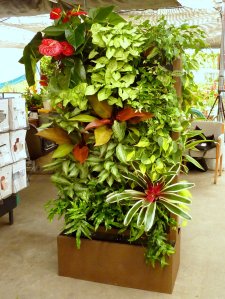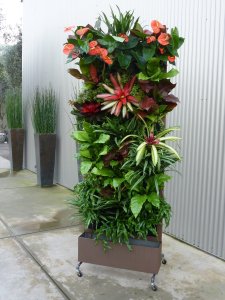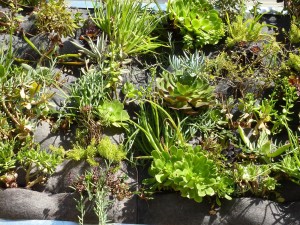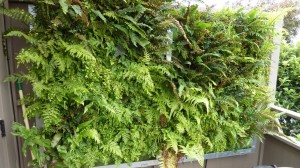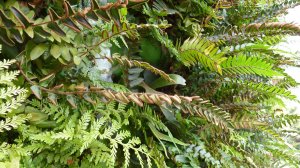Los Altos Atrium by Living Green of San Francsico
Landscape designers from Living Green of San Francisco created living walls in the courtyard of thier clients home in Los Altos using two custom-sized PlantsOnWalls Floraframe living wall systems. They used small plant starts to build living tapestries within the compact sun-filled atrium.
 |
| Designers from Living Green, San Francisco, install a vertical garden using the Floraframe living wall system. |
 |
| Custom Floraframe Living Wall Kit. Design by Living Green, San Francisco. |
 |
| Floraframe Living Wall Kits for a private residence in Los Altos. Design by Living Green, San Francisco. |
Colonie Restaurant in Brooklyn
Woodland Landscapes installed a PlantsOnWalls Living Wall Kit for Colonie Restaurant in Brooklyn, New York. The living wall measures 12' wide x 6' tall and provides herbs used by the kitchen.
[vimeo http://www.vimeo.com/20095569 w=400&h=225]
COLONIE from Karl Junkersfeld on Vimeo.
Living Wall for Ondeego
Ondeego of San Francisco ordered a living wall planted up with low-light tropicals to add life to their meeting room. The Floraframe Recirc-24 was mounted to the raw concrete wall and filled with 24 plants. Now they are inspired by green.
Floraframe Recirc-36 in Ferns
Green goes wild with a collection of ferns installed in a self-watering living wall. The Floraframe Recirc-36 is on display at the green house showroom of San Francisco Foliage.
Floraframe Recirc-36 in paint grade galvanized frame painted textred black. Includes pump, tank and timer with 36 planting pockets covered in black coverfelt and root wrappers. Can be planted full grown in as little as an hour.
Carolyn Morton Installation Video
Carolyn Morton and C&G Home Repair install a PlantsOnWalls Living Walls Kit to create a gorgeous living wall. They show us from box to wall how the vertical garden goes up..
[vimeo http://www.vimeo.com/18892716 w=400&h=225]
Living Walls from Carolyn Morton on Vimeo.
Fern Love
Ferns grace the cool northwest shady walls of a San Francisco balcony overlook. Two Floraframe 32x51 Living Wall Kits are planted with varieties of ferns.




Vertical Gardens and Livng Walls by PlantsOnWalls.
Floraframe Recirc 2x24
Fill rooms with plants with the Florframe Recirc 2x24 double-sided freestanding living wall system. Create a room-divider with a towering wall of foliage. Add 24 plants to each side using root wrappers then fill the tank with water. An automatic pump and timer keeps the plants watered so you can sit back and watch them grow. Buy Online: Floraframe Recirc 2x24
Floraframe Recirc-24
The Floraframe Recirc-24 is a self-contained living wall unit that holds 24 plants. The automatic vertical garden is self-watered with by pump and timer that lifts water to the top of the recycled PET plastic felt panel where it slowly wicks water and nutrients to each plant. The final effect is a beautiful living wall you can just sit back and enjoy. Learn More about: Floraframe Recirc Systems.
Succulent Signage
PlantsOnWalls Mini-Pocket Panels are used to grow succulents and sedums as a living background for Vox Green Design and Construction's signage in Mountain View, California.
Interview by Murrye Bernard
Murrye Bernard is a freelance architecture writer in New York City. She holds a Bachelor of Architecture and is a LEED Accredited Professional. A native of the South, her perception of space, color and texture was undoubtedly shaped by the humid backdrop of cotton fields and deteriorating downtowns.
Murrye’s work appears regularly in publications such as Architectural Record, Eco-Structure and Architectural Lighting. She also serves as a contributing editor for eOculus, the newsletter of the American Institute of Architects (AIA) New York Chapter and previously edited two newsletters for the AIA National Associates Committee.
Recently, Murrye was selected by the New York Times Company’s About.com as a contributing writer on the topic of Green Home Renovations.
--- INTERVIEW ---
Murrye Bernard: Living walls are no doubt beautiful, but are they practical for the average homeowner in terms of cost and maintenance?
PlantsOnWalls: There are many types of vertical gardens and living walls out there. Our primary goal was to make this accessible to the home gardner and landscape designers. We developed vertical garden panels with an array of pockets that plants can simply be placed in and grown in their original soil. The felt acts as a water wicking method to evenly distribute water to the roots while allowing the soil to breathe.
MB: How do these systems benefit the environment and contribute to making a home more 'green'?
POW: Living Walls decrease energy transfers through walls and can absorb solar gain on sun facing walls. The micro-biology in plants absorb toxins and filter the air which reduce air handling costs. Growing food locally saves enormous resources while teaching children to interact with nature and learn about horticulture.
MB: The goal is usually to keep water away from the surface of a wall, so applying plants vertically seems counter-intuitive when it comes to preserving a home's structural integrity and avoiding mold. How are surfaces water-proofed to receive a living wall system?
POW:The best way to protect a structure is to provide an air gap between the living wall and the building. Within the breathable air space plants and mold will not grow. Our Florafelt Vertical Garden Panels have a lightweight plastic backing board that is channeled to breathe preventing condensation on the back side. Our Floraframe Living Wall Kits provide mounting spacers that support the panels away from the wall which allows for air circulation.
MB: You offer several products - living wall kits (Floraframe), vertical gardens (Florafelt) and even a Root Wrapping System. It is it feasible for an adventurous homeowner to install these products himself? Which systems which work better for interior vs. exterior applications?
POW: The average homeowner can easily hang the Florafelt Vertical Garden Panels outdoors from the provided tabs at the top. Such a simple installation can grow herbs, vegetables, or flowers in the full sun, or ferns or mosses or annuals that thrive in shade. Interior installations are made simple with our freestanding Floraframe Recirc Systems that are framed and have a tank to recurculate water or the Florframe Living Wall Kits that can be installed and connected to internal water and drainange systems in the home for automated watering.
MB: What types of plants thrive in living wall systems?
POW: Choosing the right plants for the right spot is key. High sun exposure offers the use of rugged sedums, succulents, and cacti varieties. In Shaded areas there are countless varieties of ferns and shade-loving plants that will thrive. Part-shade offers opportunities to use varieties such as grasses, flowers, herbs and vegetables. Interior spaces are great to grow tropicals that thrive in the low-light and warm conditions where you'll find common house plants. We have tried everything from cuttings and seeds, to woody shrubs and found budding new growth to emerge from our living walls. Finding the right balance between watering, feeding and light can create a harmony that all gardeners seek to create.
MB: Tell me about a residential living wall project that you've completed and what made it successful in terms of the design and location of the wall (can be interior or exterior).
POW: One of our first residential projects was the installation of a fern wall. About two years ago we planted a variety of ferns in our vertical pocket panels. We choose ferns because we had a full shade location outside that received bright indirect light. We used a Floraframe Living Wall Kit 64" x 51" and used a Water and Nutrient Kit to provide a steady flow of moisture and nutrients. We set the timers to run for 1 minute every day and used organic based Maxsea fertilizer. The ferns filled in the entire panel with lush growth completely covering the panels themselves. It has been a successful low-maintainance living wall that flourishes with delightful beauty every day. We offer design and installation services to designers and architects, a line of products to DIY vertical gardeners, and resources for vertical garden industry professionals. See: PlantsOnWalls.com
MB: ....and if I left anything important out, feel free to address.
POW: The origin of vertical gardens began in nature where nutrient rich water flows over rock faces supporting plant life. In the 1970's Paris, Patric Blanc explored the use of synthetic materials to re-create natural vertical habitats. His hydroponic installations, he has proven the success of vertical plantings in a wide variety of locations. In recent years a number of systems have emerged in the market that have problems with binding roots, are highly complex, heavy and expensive. Our experience with vertical growing led us to develop a system that is light-weight, waterproof, quickly installed and movable. Our goal is to provide a vertical growing system that both engineers and ordinary gardeners can use. By creating a modular panel system with an array of pockets made from recycled PET plastic felt we've created a way to include soil which allows for a more people-friendly way to grow. Not uncommon from simple container gardening that we are all familiar with.
Murrye Bernard
freelance writer
www.murrye.com
FLORAFRAME RECIRC 36
The Floraframe Recirc-36 shown with paint-grade metal coated with brown texture coat and planted with tropical varieties. The complete unit is now on display at Potter Green's showroom in the Cornerstone Gallery Collection, 23586 Arnold Drive (Hwy 121) Sonoma, CA, tel (707) 996-8888.
Plants On Walls Showroom
Plants On Walls Showroom is located at 1190 Bryant Street (at 10th, across from Costco, in SOMA), San Francisco, CA 94110. Contact us to schedule a visit and tour: info@plantonwalls.com or call (415) 658-5498.
Vertical Gardens ~ Living Walls
by Trevor Smith
The concept was first demonstrated more than 15 years ago at a garden festival in France, by Patrick Blanc, a French landscape designer who had studied plant aerial growth habits in the tropics. Blanc’s hydroponically-grown plant mosaics soon appeared on prominent buildings world-wide.
Less than a decade later, living wall “systems” were being manufactured by many companies and have become readily available in the past few years. The initial interest in vertical gardens was focused on urban gardening, where traditional garden space is limited. But the beauty and versatility of vertical gardens is now drawing interest from gardeners beyond urban centers. In addition to the aesthetics, some of the benefits of vertical gardens include: lowering the temperature of buildings; air filtration; shielding building materials such as brick and concrete from heat extremes; reducing noise; creating wildlife habitat; providing edible gardening opportunities; water management when used in conjunction with storm-water and grey-water systems; and offering a more visually appealing living environment.
Originally, vertical wall systems were designed for hydroponically-grown plants, but the new systems are made up of modular planted panels that use combinations of growing medium. Individual growing cells are angled to ensure planting medium is stable while allowing maximum light exposure for plant material. Many systems provide 4” deep cells, while other systems offer deeper cells to accommodate wider plant material options. Plant options for vertical gardens include everything from grasses and groundcovers to shrubs and strawberries.
When and how plant material is irrigated is a primary concern in vertical wall installations. Systems are typically designed for efficient water use and the growing medium has been formulated to allow good drainage and aeration while retaining enough moisture to minimize irrigation cycle times. But careful attention must be paid to this area of vertical wall design, to avoid over-watering one section of the planting while under-watering another section.
Most vertical wall systems are irrigated with a drip line, but some are hand-watered. It is important to check to ensure that there is enough water going through the system to irrigate all panels and to carefully regulate the irrigation by setting up the daily watering on timers. Most frames have drip pans and catch basins for indoor applications, while outdoor applications are free-draining. Another consideration when designing vertical wall gardens is the full saturation weight of the installation.
I have used both the panel vertical wall systems as well as the “Woolly Pocket” systems. I find that most commercial soil mixes tend to be light and drain very quickly by design, but by adding biochar to the soil mix, you don’t need as much fertilizer. You will find that there is a lot of variation in the bagged soil mixes for these systems.
The modular panels can be interconnected and provide great flexibility of installation, allowing the designer to create an unlimited variety of sizes and shapes. These systems are designed for use in both interior and exterior applications. Panels are constructed of various materials, including new and recycled polypropylene as well as natural materials such as coconut fibers. Some systems are exclusively designed for mounting directly on a vertical surface while others are mounted on a stand-alone frame. Most can be easily removed and re-installed for maintenance.
There are many new residential applications for vertical walls. They can be used in place of potted plants. “Picture walls” are vertical walls used as art such as this example that I designed and installed at a private residence in Mission Hill, MA.
Some culinary enthusiasts are installing vertical gardens in their kitchens for year-round herb gardening. I have also created another innovative indoor design by constructing a wall-mounted panel to be used as a headboard.
Outdoors, vertical wall systems can be used ornamentally when mounted on walls or fences, or, free-standing installations can be planted with perennials or annuals and serve as portable urban or suburban screening on balconies, decks, or patios.
Vertical garden systems are designed to be used year after year, but special consideration will have to be made in colder climates where panels will need to be taken down or will have to be insulated to avoid winter damage. For example, in the Northeast where I practice, a wall of thyme and strawberries will either have to be brought indoors for winter or will need to be wrapped and allowed to go dormant. Plant material will have to be carefully selected in these cold climates, especially for large outdoor installations.
In addition to these ornamental installations, I envision very practical vertical gardening applications as well.
What if we take a vacant urban lot and fill it with free-standing panels, or create A-frames for use as a community garden? It doesn’t matter what the lot was before, with these systems you can control the soil and water. If the lot is sold, you can just brake down the panels and move them to another location.
I will be displaying some of my other vertical gardening designs at GreenFest Boston, Boston City Hall Plaza, August 19 – 21, 2010. GreenFest Boston is the region’s largest multicultural environmental festival.
A living wall is more like container gardening than a perennial bed, when it comes to managing water and nutrients. But it gets planted like a perennial bed and, like a perennial bed, the wall will be different in subsequent seasons. Just like any perennial bed, it is not a ‘set it and forget it’ landscape element. It is going to need to be tended to – things will die and need to be replaced. Success with living walls requires thought and maintenance. You are going to have to find the rhythm in your wall.
Trevor Smith is the owner of Land Escapes, a full service ecological landscaping company in the Boston area that specializes in Garden Design, Eco-Rain Recovery, Water Features, and Living Wall Installations. Trevor is also the Vice President of the Ecological Landscaping Association. You can reach Trevor through his website: www.everydaygetaway.com.
How to Make a Living Wall -wikiHow
originated by: beerbrewingchronicles.com, Miss Bossy Britches, Maluniu, Flickety
A living wall is a vertical arrangement of plants and other organisms that naturally removes toxins and unhealthy contaminants from the air that we breathe. Living walls can be complete ecosystems or simpler configurations of plants that thrive in and help to decontaminate urban environments. Many living walls are indoors, but they can also be outdoors, such as on the exterior walls of buildings.
1 Decide if the living wall is to be set up indoors or out.. An indoor living wall will help to remove toxins from the air. Indoor air can be very high in pollutants and toxins, and given that most people spend the majority of their time indoors, this can impact on your health dramatically. Outdoor living walls can help to improve the exterior environment, but may be primarily used to reduce energy costs during the summer months. Also consider what an exterior living wall will look like during the winter. Indoor living walls can be relatively small and simple, while outdoor walls may be very large and cover a large area of a building. Also, indoor walls will be easy to water and take care of, while outdoor walls will complicated, and perhaps require special building permits and permission from members of the community. A simple exterior living wall may consist of a climbing plant that grows up a wall from the ground. However, it may take a decent amount of time for this type of living wall to grow and become established.
2 Choose the appropriate plants and other organisms. Living walls are primarily composed of plants that absorb and filter out airborne toxins. All plants are able to remove toxins, but some plants are better at filtering out such harmful substances than others. The plants that are especially good at removing toxins include: azalea, bamboo palm, chrysanthemum, spider plant, aloe vera, English ivy, elephant ear philodendron, golden pothos, and peace lily. Different plants can remove different types of toxins, so use a variety of plants. Choose plants that are well adapted to the environment that they will be living in. Account for light intensity (indoor, outdoor, shade, full sun), available water, humidity and temperature. Other organisms that can be used include soil microorganisms and aquatic animals. Soil microorganisms also help to remove toxins, so fertilize the soil with natural, microbe-rich fertilizers. Certain aquatic animals such as fish, amphibians, and mollusks that consume algae and such can help to make a living wall a complete, essentially self-sustaining ecosystem.
3 Build a structure for the living wall. The living wall will be primarily vertical, but can have a bottom area that serves to house additional plants and an aquatic area. A simple structure can consist of a series of shelves. An array of plant containers can also be attached to a wall or hung from the ceiling. A more complicated structure may consist of a vertical wall and a horizontal base. A reinforced layer of growing medium intact with living plants may be hung vertically on a wall that has been waterproofed with plastic sheeting. In this instance, the plants will grow out horizontally from the vertical growing medium. Be sure to align the structure so that every plant will obtain adequate light once situated, and that every plant can be watered properly and easily. This may involve staggering the shelves or containers in some manner, perhaps somewhat horizontally. The vertical wall should be permeable to some extent so that air can pass through it. At the very least, air should be able to freely pass of over or past the wall. Also keep in mind that the growing medium must be somewhat permeable to air (so should not too dense or completely watertight), as the roots of plants require some oxygen. Air should circulate through or over the wall so that the airborne toxins can be absorbed and removed. If making a large or complex wall, an irrigation system (such as a drip irrigation system) should be part of the wall. Walls that consist of a vertical layer of growing medium should be watered with an irrigation system, and water will most likely need to be supplied from the top so that it can trickle down to the bottom. It may be important to use many small plants, and perhaps just mosses, for the vertical wall. The base of the wall may contain larger plants and an aquatic area.
4 Set up an air re-circulating system. If the wall is indoors, the contaminated household air must be circulated over and ideally through the living wall. This will enable the wall to absorb the toxins from the air, as well as help to ensure that the plants remain healthy. If air is actively drawn through the wall, the living wall can be referred to as a biofilter. One box fan can be used to circulate air, or a more complicated system of fans and ducting can be used.
5 Arrange the lighting for the plants. Plants require light, so make sure that they receive enough artificial or natural light. If possible, place the living wall near a window or skylight that receives direct sunlight. Natural light can be supplemented with artificial light. Regular incandescent light bulbs will not provide adequate light for the plants, but essentially any fluorescent light will work. Regular compact fluorescent bulbs can be focused or directed towards the wall to provide high-quality artificial light. There are also other, more specialized grow lights that are used for plants. A timer can be used to turn artificial lighting on and off during the day and night. Be conscientious of the animals that may live in the wall, and provide them with shade and hiding places.
6 Situate the plants in the living wall. The plants may live in soil or a hydroponic medium. If the wall is to be a primarily self-sustaining ecosystem, it should be much easier to use soil as a planting medium. The wall may be partially hydroponic, but be aware that hydroponic chemical plant nutrients may destroy or disrupt the non-hydroponic component of the living wall.
7 Water and fertilize the plants. Different plants have particular water and fertilizer requirements. Over-watering and under-watering can result in unhealthy plants, and perhaps harmful mold growth. Use living, organic fertilizers to introduce beneficial microorganisms to the wall. If animals are living in the wall, be careful not to contaminate their immediate environment and water and food supply with potentially toxic fertilizer. Use fertilizer sparingly, as it can easily kill the plants and other organisms that make up the living wall.
HISTORY
PlantsOnWalls Showroom Planting
Here's a close look at the planting for our showroom's facade (from left to right). This full sun exposure gave us the opportunity to try out a lot of things. (2 months growth)
We used full-pocket panels (12 F-12s) with one pocket trimmed off the top to fit between the windows. The galvanized living wall kit frames the panels to finish the edges, float the panels from the building, and collect the dripping in the bottom tray. Soaker hoses are threaded through the top of the pockets every 4 rows down and connected in the top tray where there is room to access tubing. The 1/4" line is connected to a hose connector inside the building and operated by a digital hose timer and connected to a water filter and food injector. Short cycles fairly often keep the moisture absorbing felt at optimum moist/dry cycles.
Swing by the PlantsOnWalls Showroom at 10th and Bryant in San Francisco SOMA and watch it grow.
Global Green Fashion Show
Josiah Cain for Design Ecology used Plants On Walls vertical garden panels for the Global Green fashion show December 13th, 2010 at the W Hotel in San Francisco.
Fern Wall
The fern wall on my back patio gets more and more lush as it matures. It also begins to build a more natural character as the plants find their place. This wall goes largely ignored because it is on automatic watering systems. Ever since I began using a food injector, the plants really began to burst out. This wall has been growing for nearly two years now.









